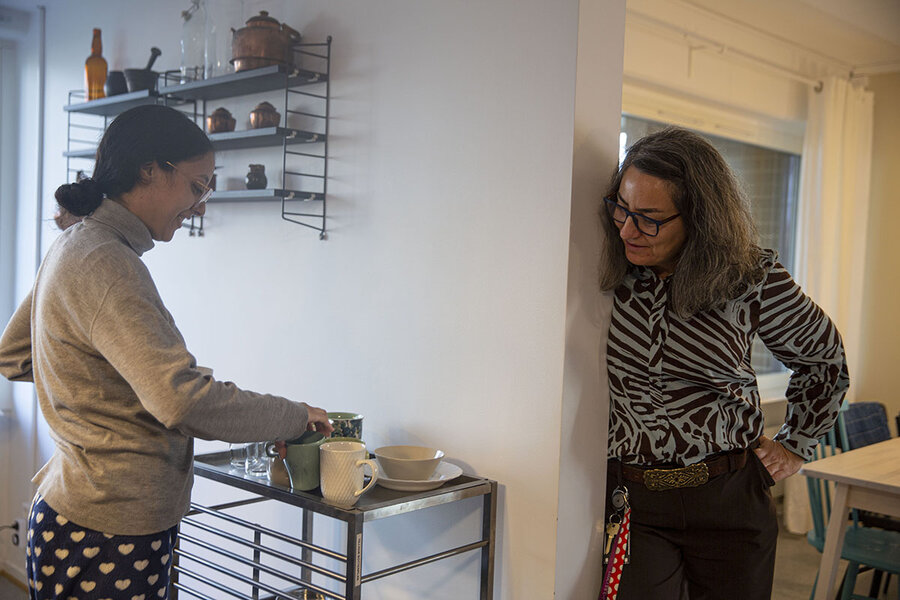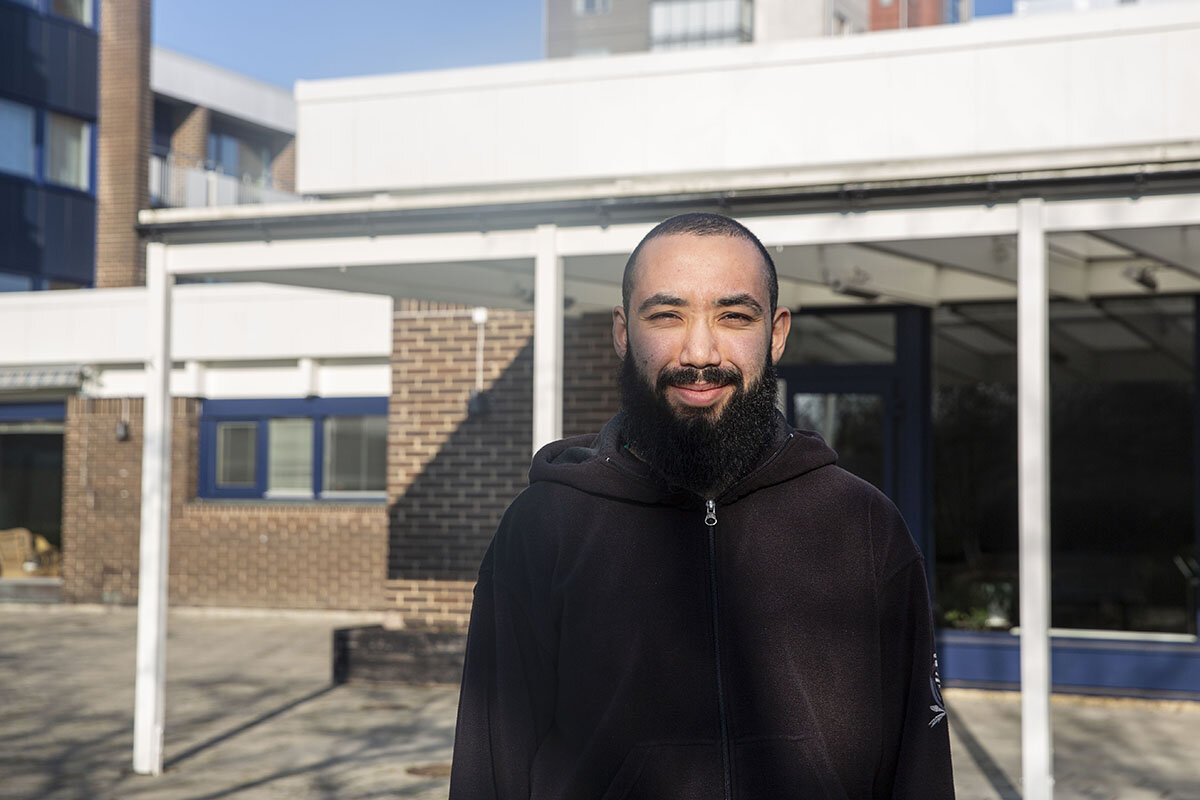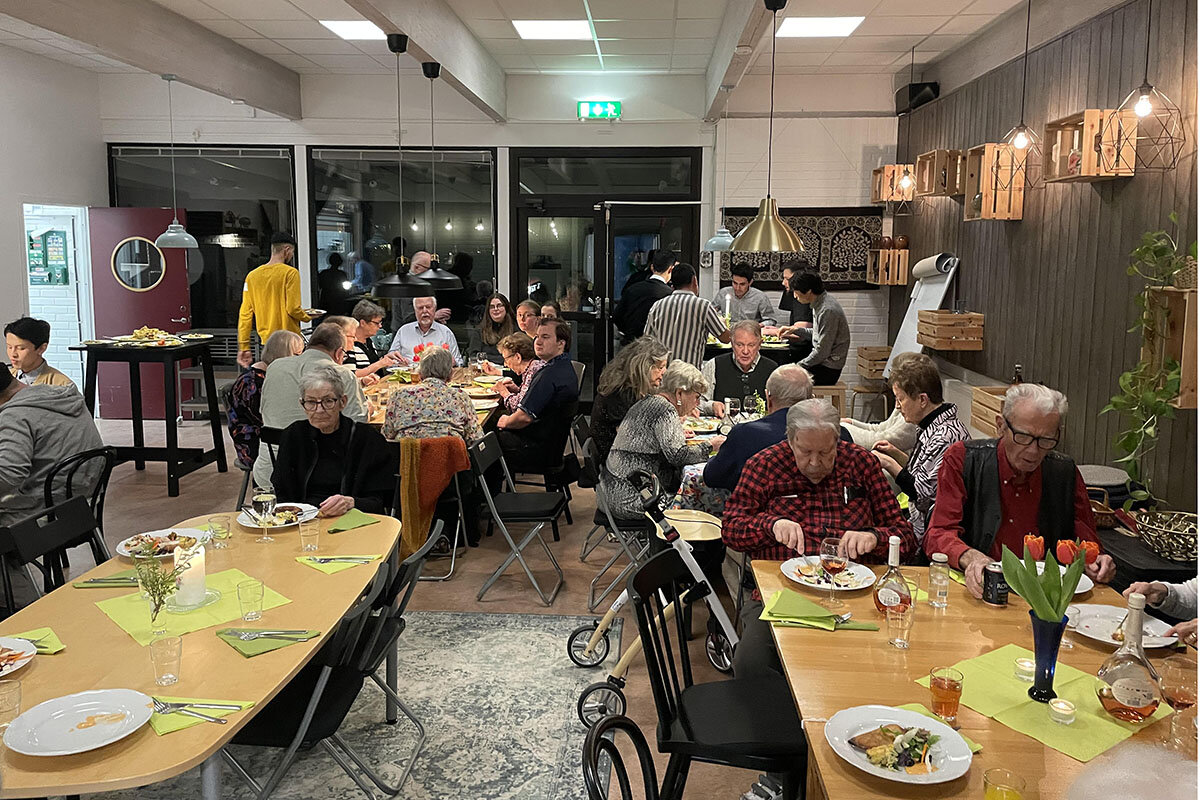By sharing housing, seniors and migrants in Sweden build bridges
Loading...
| Helsingborg, Sweden
It was when his older Swedish neighbors threw him a high school graduation party that Afghan native Zia Sarwary finally felt a sense of belonging in this picturesque seaside city.
“It meant everything to me,” says Mr. Sarwary, who at the age of 13 arrived alone in Sweden during the 2015 refugee crisis. “That was the beginning of feeling at home.”
Mr. Sarwary is one of dozens of tenants living in Sällbo, a shared-living project mixing elder Swedes and young adults, some of them from Sweden, others – like him – from the Middle East or Afghanistan. The six-story building with 51 apartments helps counter both the loneliness of advanced-age Swedes and the integration difficulties facing migrants who arrived as unaccompanied minors.
Tenants of Sällbo have found common ground within these colorful walls, which they attribute to the cumulative impact of courtesy, kindness, mutual curiosity, and understanding.
“The whole goal was to show that even if you are different and even if you are people who would not usually socialize, you would do so if there is a safe environment where you know who is in the house,” says Dragana Curovic, the project manager for Sällbo. “After three years, we can say that it worked.”
“We can meet in the middle ground”
Had they not moved under the same roof, the older Swedes and young migrants living here would almost certainly not have mingled. Fear and misunderstanding would have been major obstacles. Older Swedes’ impressions of young migrants draw heavily on negative press reports linking them to crime.
As for the immigrants, their interactions with Swedes had largely been limited to asylum center officials – authority figures who set the initial tone for the newcomers’ experience, but weren’t focused on building bonds with them.
Sällbo attempts to overcome that by getting tenants engaged with each other. To move in, tenants must agree to socialize at least two hours per week. That can happen in shared kitchens, activity rooms, or cozy living areas. Each floor boasts three common areas, ranging from puzzle and scrapbooking rooms to libraries and film-screening rooms to carpentry workshops. Sun-kissed kitchens are set up for mingling, growing herbs, pickling, and baking. Artwork decorates the hallways.
Intergenerational living projects exist around the world, but the one at Sällbo stands out for its integration of migrants. Young and old concur that the pandemic helped strengthen the bonds that bind them. Younger residents did grocery shopping for the elders, who returned the favor by helping those with low computer skills keep up with their classes online.
Now a logger working night shifts, Mr. Sarwary wishes he had even more time to spend with his older neighbors and feels bad when he needs to cut conversations short to catch his bus. After all, elders are treated with deference in Afghanistan. He believes curiosity feeds residents’ capacity to find common ground across cultures and age groups.
“People try to understand each other,” he says. “I know you have your differences. I have mine. But we can meet in the middle ground and do something together that is good for both of us. There is a positivity in everything. That is the best part.”
“Sometimes you do things that are not correct,” Mr. Sawary continues. “Instead of people coming in scolding you, they come in and they’re like, ‘Oh, you could do it this way.’” That attitude manifests itself in small tasks he performs, such as helping an older resident change a lightbulb, and in longer endeavors such as a neighbor teaching him how to drive.
It helps that people understand that he had a tough background and approach him with an open mind to learn about his headline-grabbing, war-torn homeland.
“They would always ask instead of just judging. ‘OK, is this true about your country?’” he says. “Even now they ask [questions] here in Sällbo. Everywhere else they don’t even ask. They have this picture in their head about you. ... In Sällbo, what I like is that they are very curious.”
“I love the young kids”
Jan Gustavsson, a retired provider of security systems, says he like helping young people from Afghanistan and other parts of the world integrate. “We can see in other places where no one does anything, there’s a lot of crime,” he says. “Like in Stockholm and Gothenburg, there’s a lot of problems with them.”
“I think it will help if these people live together with Swedish people,” he adds. “They learn more about the Swedish customs and traditions. They get to know other people. Their Swedish improves.”
Anki Andersson oversees scrapbooking activities on Tuesdays. Her husband, Kalle, helps fellow seniors do seated workouts. “Sällbo is the perfect place if you are mobile and seeking to socialize,” says Ms. Andersson. “People here are so alike in a way. It is hard to explain. We click together very well, both the older and young residents.”
“They were very helpful during the pandemic, but also before and after,” she says of the young people. “If we have something we need to do or heavy things to carry, they give as a hand. We are a big family.”
Retired schoolteacher Gunilla Olsson feels especially at home. She is still touched that one of the girls studying to become a doctor brought her chocolate. It was a gesture of thanks to her for always saying good night as she passed the study on her way to her apartment every night.
“I love the young kids,” says Ms. Olsson “It’s so good to have them around with their smiles. It is so good for old people to be around young people.”
“I love the different ages and cultures,” concurs Ritva Gustafsson, a retired Swedish language teacher. “I love it because they are still looking forward to something. We have things behind us so we can bring them something. And they can bring us something. It is very exciting to share the experiences of their home countries.”
Conversations can turn political and ethical, she notes. But even amid differences of opinion, they do not turn as heated as they might at a family dinner table. “When people are discussing values, when something happens, they put forward what they think and why they think it,” she says. “There is respect.”
The biggest trigger for low-level shared living conflict? “Fluff,” says Sonja Håkansson, who oversees the building. “Laundry fluff and dishes.”
The project “has worked better than I thought it would,” she says. “Having so many different personalities and different ages from other cultures, I thought that was going to be a bigger issue. But people find their similarities.”
“We are interlinked”
Safety is central to the smooth functioning of the building. Guests are allowed – and can even stay overnight in a room set aside for visitors – but must always be accompanied by their host. The night lights are always on. Each floor has its own cheerful color scheme to make it easier for aging people to find their bearings.
But the real safety comes from knowing each other and watching out for each other. Neighbors are quick to notice when someone is not around or has fallen ill. “You can always knock on someone’s door,” says Ms. Gustafsson.
Amel Ben Jmaj, a biotech student from Tunisia, is one of the newest tenants and already loves the place. She recently moved in to join her fiancé, a construction worker, and is awaiting her Swedish residency permit.
“It is a completely different way of living,” she says, finishing up the dishes as she makes plans to make baklava for an upcoming party. “We are interlinked. We play puzzles together, watch films, and throw parties. It’s heaven.”
Editor’s note: Dates on some photographs have been corrected to read “2023.”









